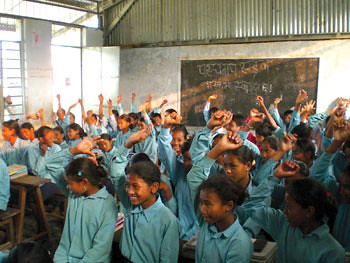
KUNDA DIXIT
Quantitatively, Nepal has made impressive progress in basic education in recent decades: 90 per cent of children enrol in primary schools and there is virtual gender parity in enrolment. Nearly four per cent of GDP and 17 per cent of our national budget are allocated to the education sector.
But the quality of education in government schools is so poor that eight per cent of children in Grade 1 drop out and 23 per cent repeat the grade. Only 70 per cent of the original cohort complete the primary cycle and less than a third reach Grade 10. Less than half the students from public schools appearing in the SLC exam pass, compared to 90 per cent of those from private schools.?Basic education is a fundamental human right, but we see a dual education system: one for the rich and one for the poor.
So far, very few attempts have been made to bridge this gap. Here is a 10-point checklist to improve the quality of basic education and turn it into a strong foundation for national development:
1. Expand early child development programs:
Nepal’s politicians and community leaders tend to give higher priority to upgrading schools from primary to secondary and from Plus-2 to universities as signs of educational progress. We need to reverse this trend and give greater priority to building a strong foundation for life-long education starting in the earliest years of a child’s life.
2. Make schools child-friendly:
Many children fear going to school. Teachers are often untrained, uncaring, and quick to give corporal punishment. Schools are dirty and lack minimum sanitary facilities, especially for girls. The method of instruction involves rote learning rather than encouraging children to explore and understand what they are learning.
A test of whether a school is truly child-friendly is to ensure that it is especially girl-friendly. There are excellent child-centred learning approaches in Nepal, we need to benefit from these experiences.
3. Increase women teachers:
A strategy for making schools more child-friendly is to vastly increase the number and proportion of female teachers. Having more women as primary teachers is not only desirable because of gender equality and social justice, but it has a very direct impact on enrolment and retention of girls in schools. Only 40 per cent of teachers at the primary level, 17 per cent in lower secondary, and a miserable 13 per cent in higher secondary schools are women. We must adopt affirmative action to aim for at least half of all teachers being women in the next five years.
4. Affirmative action for the disadvantaged:
While enrolment of over 90 per cent in primary schools is impressive, the 10 per cent who are out of school are mostly from the historically, geographically, economically, and socially deprived communities. Only 38 per cent of children from indigenous communities, 20 per cent of Dalits, and a mere one per cent of disabled children are enrolled in primary schools. An aggressive affirmative action plan is needed to ensure extra support in basic education for the disadvantaged.
5. Make education inclusive and multi-cultural:
Historically our education system has not been responsive to our diversity. Our text books perpetuate a stereotypical image of traditional inegalitarian Nepali society. The language of instruction is mostly Nepali or English, both neglect mother tongues and over-emphasise rote learning. This is pedagogically unsound. But it would be unwise to follow a rigid formula in this regard. Pedagogical soundness and parents’ wishes should be given priority over the wishes of ethnic or linguistic activists.
6. Focus on quality:
Our new slogan should not be just education for all, but quality education for all. These interventions require changes in attitudes and behaviour, not necessarily huge capital intensive investments. Over-crowding in classrooms is another problem, especially in the Tarai. Nepal has a shortage of at least 60,000 primary teachers. We need more teachers, not more soldiers.
7. Cultivate public-private partnership in education:
While some private schools offer quality education, many are seen as highly commercialised enterprises. Nevertheless, private schools do meet a felt need of parents for quality education. Instead of threatening to close private schools, or disempowering them through excessive political interference and over-regulation, Nepal should harness the power of public-private partnership to improve the quality of basic education.
8. Transform schools into Zones of Peace:
During the conflict, many schools became battle zones, much intimidation and violence was inflicted against children, and education was seriously interrupted. A number of Nepali and international organisations introduced the idea of children and schools as Zones of Peace.
9. De-politicise basic education:
Currently Nepal suffers from hyper-politicisation that affects all aspects of life. Teachers’ unions, students’ organisations, and educational institutions, even at the primary level are not exempt from political activism, often quite unrelated to genuine educational issues. All political parties in Nepal are guilty of such politicisation of education.
10. Education as genuine peace dividend:
Now that peace and democracy are at hand, we must make up for all the lost time and opportunity. Let us redouble our investment in education by creating a peace dividend of reduced military expenditure and other wasteful expenses. Let us recognise that education is not only a human right, it is the engine of all human development.
Kul Chandra Gautam is former Assistant Secretary-General of the United Nations and Deputy Executive Director of UNICEF. This is an excerpt from his keynote address to the international conference, Quality in the Classroom, organised by Rato Bangala Foundation from 4-7 April 2013.
[email protected]
www.kulgautam.org